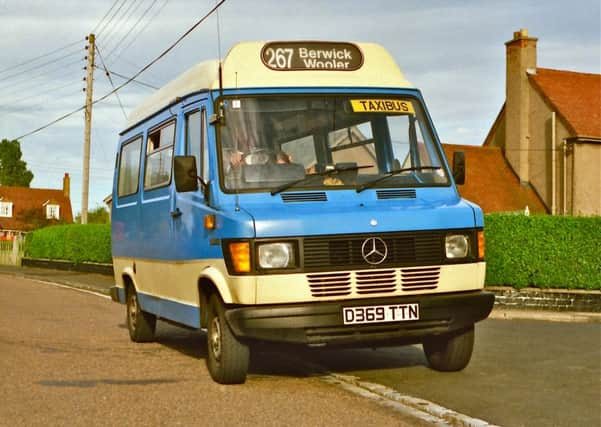The rise and fall of the taxibuses


The deregulation of bus services happened earlier here than in the rest of England.
This is because the Scottish school term starts in mid-August, and it was expedient for the changes to happen before the start of the school term.
Advertisement
Hide AdAdvertisement
Hide AdOne of the provisions of the 1985 Transport Act was to allow licenced hackney carriages (taxis) to operate bus services.
However, a taxi, by definition, cannot have more than eight passenger seats, and so it was obvious that such a use could have only a very limited application.
By national standards, of course, Berwick is a small town, and the surrounding countryside is thinly populated.
As such, demand for public transport, especially in the evening, is so small that full-size buses are just not economic.
Advertisement
Hide AdAdvertisement
Hide AdBut 30 years ago there was just enough demand on certain strategic routes in the area to justify the use of a taxibus.
The arrangement at deregulation was that bus operators would run whatever they could at a profit, and then the local authorities would commission whatever services they deemed necessary to fill the remaining gaps in service provision.
In this area there were even gaps which could be filled by very small vehicles during the day.
All was not sweetness and light, however.
The Government encouraged the use of taxibuses by making them legal, but it omitted to tell HM Customs to give them a level playing field.
Advertisement
Hide AdAdvertisement
Hide AdConsequently, taxibus operators suffered financial disadvantages, and as a result this eventually led to the failure of the taxibus operations in this area.
The taxibus services that were started 30 years ago, and finished some 20 years ago, did leave their mark, however.
It is noticeable that the only bus routes within a very wide area that have regular hourly services even now through the evening are between Berwick and Spittal, and between Berwick, Eyemouth and St Abbs, and that is the legacy of the taxibuses.
Berwick was at the farthest flung corners of the networks of the English and Scottish bus companies, both of which have largely withdrawn their interest in this area.
Advertisement
Hide AdAdvertisement
Hide AdThe two remaining routes from Berwick to Newcastle have resolved into a very satisfactory operational pattern, but one hears that they are not economic north of Alnwick, so we can expect some modification after the summer.
Within the town and on the Scottish side, almost all services are now in the hands of the main local operator, which is now in the ownership of the excellent West Coast Motors company of Campbeltown.
We may therefore dare to hope that we shall see, in due course, a more comprehensible route pattern and timetable of town services, which will then be even better used than the present ones.
On the rails, the Rail Action Group East of Scotland (RAGES) continues its campaign to elicit firm commitments from the Scottish Government and Scotrail to build and provide services to Reston station, which seems to recede ever further into the future.
Advertisement
Hide AdAdvertisement
Hide AdThe Chairman of the Campaign for Borders Rail (CBR) Allan McLean has reminded us that, having achieved success with the re-opening of the Borders Railway, the campaign is putting its weight behind Reston too.
Let us hope for success before too long.
• John Wylde is the author of Integrated Transport – a Will-o’- the-wisp? This book is priced at £14.95, post paid and signed by the author. Also Experiments in Public Transport Operation, at £11.95. Order through the author’s website at www.john-wylde.co.uk